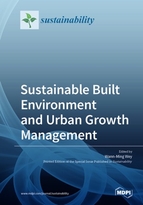Sustainable Built Environment and Urban Growth Management
A special issue of Sustainability (ISSN 2071-1050). This special issue belongs to the section "Environmental Sustainability and Applications".
Deadline for manuscript submissions: closed (30 June 2018) | Viewed by 61718
Special Issue Editor
Interests: urban built environment planning and design; sustainable transportation; smart city and big data; growth management with urban development
Special Issues, Collections and Topics in MDPI journals
Special Issue Information
Dear Colleagues,
During the past decade, there has been an increasing interest in the link between sustainable built environment and the urban growth management in the field of urban studies. This interest is motivated by the possibility that urban development planning and design principles associated with the built environment can be used to manage individual activities and improve the quality of urban life. Sustainable built environment is relatively important to urban growth management that deals with environmental problems, housing issues, and community well-being. Nowadays the sustainable built environment planning in most cities has come to a turning point, as the traffic and population growing has become a serious concern and put a tremendous pressure on both environment and people in these cities. It is therefore important to find ways or new lifestyles such as compact city, transit-oriented development (TOD) formulations that are more flexible, inclusive, and sustainable. Furthermore, for the sustainable built environment and urban growth management, not only the growth management principles which include Smart Growth, Sustainable Growth, and Inclusive Growth should be taken into account, but the innovative/smart planning strategies such as mixed use design, green transport and new urbanism are utilized in planning sustainable build environment in order to prevent the urban sprawl development happened. On the other hand, a number of built environment attributes, measured both objectively and subjectively, were related to levels of physical activity, including walking, cycling, or driving etc. The priorities for built environment planning were arranged according to different weightings of them. Thus, the priorities in resource allocation were clearly defined, thereby preventing poor resource management and wastage which will be importantly addressed in this special issue.
From the viewpoint of the studies on the link between sustainable built environment and urban growth management and their interactions, this Special Issue welcomes theoretical and empirical studies on the following topics:
- Sustainable built environment planning and design;
- Sustainable growth management strategies;
- Urban design and planning opportunities in high density living areas;
- Mixing up residential and commercial uses in inner cities;
- Growth management principles in smart city planning and designing;
- Low-carbon community under smart growth;
- Walkability/cycling and built environments;
- Sustainable living environment;
- Elderly-friendly living environment in the community;
- Enhancing quality of life in community using environmental design;
- Resilience and vulnerability for urban development;
- Policy-making and sustainable government initiatives for future cities;
- Big data and smart city;
- Urban design innovation for smart cities;
- Intelligent use of Information and Communication Technologies (ICT) to sustainable built environment and smart cities research including data mining, cloud computing, Internet of things (IOTs), etc.
Guest Editor
Manuscript Submission Information
Manuscripts should be submitted online at www.mdpi.com by registering and logging in to this website. Once you are registered, click here to go to the submission form. Manuscripts can be submitted until the deadline. All submissions that pass pre-check are peer-reviewed. Accepted papers will be published continuously in the journal (as soon as accepted) and will be listed together on the special issue website. Research articles, review articles as well as short communications are invited. For planned papers, a title and short abstract (about 100 words) can be sent to the Editorial Office for announcement on this website.
Submitted manuscripts should not have been published previously, nor be under consideration for publication elsewhere (except conference proceedings papers). All manuscripts are thoroughly refereed through a single-blind peer-review process. A guide for authors and other relevant information for submission of manuscripts is available on the Instructions for Authors page. Sustainability is an international peer-reviewed open access semimonthly journal published by MDPI.
Please visit the Instructions for Authors page before submitting a manuscript. The Article Processing Charge (APC) for publication in this open access journal is 2400 CHF (Swiss Francs). Submitted papers should be well formatted and use good English. Authors may use MDPI's English editing service prior to publication or during author revisions.
Keywords
- sustainable built environment
- urban built environment planning and design
- urban growth management
- smart growth principles
- sustainable growth
- inclusive growth
- urban design
- new urbanism
- compact city
- transit-oriented development (TOD)
- sustainable transportation
- walkability and cycling
- environment planning and evaluation
- future/smart city
- big/open data
- innovative planning technology.






